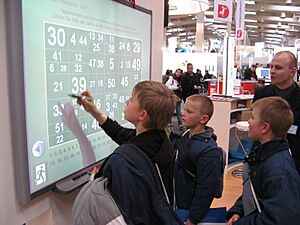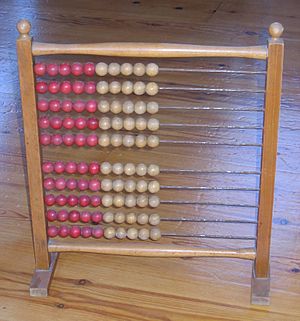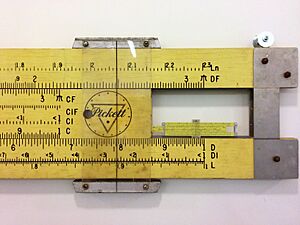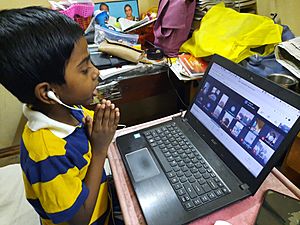Educational technology facts for kids

Educational technology, often called EdTech, is about using computers, software, and smart teaching ideas to make learning and teaching easier and more fun. Think of it as all the cool digital tools and methods that help you learn, whether you're in a classroom or at home. It's also the name for the companies that create these tools. EdTech uses ideas from many fields, like how we communicate, how our brains learn, and how computers work. It includes things like online courses, learning apps on your phone, and even special computer programs that help you learn at your own speed.
Contents
- What is Educational Technology?
- How EdTech Started and Grew
- How We Understand Learning with Technology
- How EdTech is Used in Practice
- Cool Technologies in Education
- Where EdTech is Used
- Good Things About EdTech
- Challenges with EdTech
- Teacher Training for EdTech
- Checking What You've Learned
- Understanding Learning Data
- See also
What is Educational Technology?
Educational technology helps people learn and teachers teach. It uses tools and methods to improve how we share knowledge. This can be anything from old tools like the abacus to modern virtual reality systems.
EdTech includes:
- New ways of teaching and learning.
- Digital tools like online courses that help share knowledge.
- Systems to manage student information and school lessons.
- Tools for school operations, like managing budgets.
- Learning about computers and information and communications technology (ICT) in school.
Words We Use in EdTech

Educational technology is a big term. It covers all the tools and processes that help learning and teaching. This includes both old and new methods. It's not just about modern digital tools. It also includes any resource that makes teaching better.
People who work in this field are called educational technologists. They design and test learning systems. In the UK, they are often called learning technologists.
Modern EdTech includes many terms like:
- E-learning: Learning using electronic resources.
- Online learning: Learning completely over the internet.
- Mobile learning (m-learning): Learning on phones or tablets.
- Virtual learning environments (VLEs): Online platforms for courses.
These terms often describe similar ideas. They just focus on different parts of how technology helps us learn. For example, m-learning highlights learning on the go. But its main goal is still to help you learn, just like other EdTech.
Sometimes, "virtual education" means learning in a simulated world. But usually, it means any course taught mostly over the internet. It's "virtual" because you don't go to a physical classroom. This type of learning uses online tools, videos, and video calls.
When learning is everywhere, like on devices you carry, it's called smart learning. This is part of the idea of a smart city.
How EdTech Started and Grew
People have always looked for ways to learn better. Early tools like cave paintings and the abacus helped. Writing slates and blackboards have been used for hundreds of years. Books also played a big role.
In the early 1900s, educational films appeared. Then, in the 1920s, Sidney Pressey created mechanical teaching machines. These were early steps in EdTech.
In the 1960s, professors at Stanford University used computers to teach math and spelling. They used special typewriters connected to computers.
Online education began in 1960 at the University of Illinois. Students could access class info using computer terminals. The internet wasn't around yet. True online learning started in 1982. A school in California offered a distance learning program for business people. It used computer conferencing.
By 2002, MIT started offering free online classes. By 2009, about 5.5 million students took at least one online class. Today, many college students take online courses. In 2014, 2.85 million students took all their courses online. The number of students learning online has steadily increased.
In the 1970s and 1980s, computers became more common in learning. The UK had programs to support computer-aided learning.
Videoconferencing was also important. It connected students with experts and museums. But it often had grainy images and needed special equipment.
The Open University in Britain and the University of British Columbia helped start using the internet for learning. They used web-based training and online discussions.
By 1994, the first online high school was created. The internet improved, allowing new ways to communicate with videos and webcams. The number of K-12 students in online learning grew by 65% from 2002 to 2005. This offered more flexibility and quick feedback.
By 2008, about 66% of US colleges offered some distance learning. The Council of Europe supported e-learning for better education.
In 2015, more students enrolled in online courses at private non-profit schools than at for-profit ones. Public universities still had the most online students. By fall 2015, over 6 million students took at least one online course.
In 2020, the COVID-19 pandemic forced many schools worldwide to close. This led to many students learning online. Organizations like Unesco helped schools with distance education. The pandemic caused a huge increase in money invested in EdTech companies. In 2020, US EdTech startups raised $1.78 billion. This was much more than in 2019.
How We Understand Learning with Technology
Educational technology uses different ideas about how people learn. These ideas help design better learning tools.
Learning by Doing and Rewards
One early idea, called behaviorism, focused on how actions are learned through rewards and punishments. Think of training a pet. This idea influenced early teaching methods. B.F. Skinner wrote about using this approach to improve teaching.
Learning by Thinking
Later, cognitivism became popular. This idea looks at how our brains process information. It's about how we remember, store, and use what we learn. Computers helped us understand how our memory works. This idea helps design lessons that match how our brains think.
Learning by Building Knowledge
Constructivism suggests that learners build their own understanding. They use what they already know and new information. Teachers become guides, helping students explore and discover. This often involves problem-based learning or project-based learning. Students work on real-world problems. For example, early computer programming languages like LOGO tried to help kids build their own knowledge.
How EdTech is Used in Practice
EdTech can be used in many ways. It can help in a classroom or be the main way you learn online.
Learning Together or Alone
Learning can be synchronous or asynchronous.
- Synchronous learning happens in real-time. Everyone interacts at the same time. Examples include live online classes, video calls, or chat rooms. This helps students work together and learn from each other.
- Asynchronous learning is self-paced. You learn on your own schedule. This uses tools like learning management systems, email, blogs, and videos. It's great for students who need flexibility. They can complete work at their own pace.
Step-by-Step Learning
Computer-based training (CBT) means learning activities on a computer or tablet. It often presents information step-by-step, like an online book. CBT is good for learning fixed processes, like how to use software. Tests in CBT are often multiple-choice. They give instant feedback. CBT can include videos and animations to make learning more interesting. However, creating good CBTs can take a lot of effort.
Working Together to Learn
Computer-supported collaborative learning (CSCL) encourages students to work together. This is like "e-learning 2.0." It uses social software like blogs, wikis, and discussion groups. Students learn by talking about topics and solving problems together. This is different from just listening to a teacher. Social networks help create online learning communities. For example, students can use apps to study together.
Classroom 2.0 uses online virtual worlds to connect schools. This allows students from different places to learn together. It helps them understand other cultures.
Social media also helps students learn. It lets them connect with experts and share ideas. For example, teachers have used Twitter to analyze real-world events.
Flipping the Classroom
In a flipped classroom, you learn new material at home using technology. This might be through educational videos or online tools. Then, in class, you work on harder tasks with your teacher. This can improve learning and make students more engaged. It also offers flexibility. But it needs students to be motivated and have good internet access. It can also mean more work for teachers.
Cool Technologies in Education

Many types of technology are used in schools today. These include digital cameras, video cameras, and interactive whiteboards. They also include online tools like blogs and virtual classrooms.
Sound and Video Tools
Video has been used for a long time, from VHS tapes to DVDs. Now, we have online videos and webcams. Videotelephony lets you talk to experts far away. Even video games are used in schools.
Screencasting lets people share their computer screens online. This makes it easy to show how to do something. Webcams are also used for online classes. They help create virtual classrooms.
Computers, Tablets, and Phones
Computers and tablets help students access websites and apps. Many phones support m-learning, which is learning on the go. Devices like clickers and smartphones can be used for quick quizzes. They also help with reminders and instructions.
iPads are used to help children with disabilities communicate. They also help improve physical activity. Digital devices can make learning fun and interactive. They help students develop digital literacy and 21st century skills.
Small Computers and Smart Devices
Small, easy-to-program computers like Raspberry Pi and Arduino are great for learning coding. They can connect to sensors and robots. These devices are part of the "Maker Culture." This culture encourages tinkering and building with electronics.
Working Together Online
Group webpages, blogs, wikis, and Twitter help students and teachers share ideas. Social networking sites create online communities. Students can talk by voice, chat, or video. Many students use social media to talk about schoolwork. This helps them work together and feel more confident.
Interactive Whiteboards
There are different kinds of whiteboards. Old ones were like blackboards. Now, we have virtual whiteboards on computers. Interactive whiteboards let you write on a touch screen. You can write on a blank screen or on any computer content. This makes learning visual and interactive.
Virtual Classrooms
A virtual learning environment (VLE) is like an online classroom. It uses different communication tools at once. Web conferencing lets students and teachers talk with webcams and microphones. You can raise your hand, answer polls, or take tests.
A virtual classroom gives students direct teaching from a teacher. They get instant feedback. It also provides a schedule, which helps some students. It creates a social learning environment, like a regular classroom. Many universities offer online degrees.
By April 2020, about 90% of high-income countries offered online learning. Only 25% of low-income countries did. This was due to the COVID-19 pandemic.
Augmented Reality
Augmented reality (AR) technology will play a big role in future classrooms. It blends digital information with the real world.
Learning Management Systems
A learning management system (LMS) is software that helps deliver, track, and manage learning. It records attendance, time spent on tasks, and student progress. Teachers can post announcements, grade work, and lead discussions. Students can submit work and take quizzes. An LMS helps everyone track learning. Creating good learning content for an LMS takes a lot of effort.
Online Tests
Computer-aided assessment (e-assessment) uses computers for testing. This can be simple multiple-choice tests or more complex systems. Some systems give feedback on specific mistakes. They can also adapt questions based on what a student has learned. This helps teachers understand student progress.
Training Management Systems
A training management system helps manage training for instructors. It helps with planning, scheduling, and tracking costs.
Artificial Intelligence in Learning
Artificial intelligence (AI) has been studied since the 1950s. Early uses of AI in education were intelligent tutoring systems (ITS). These systems give personalized feedback to students. They help students learn at their own pace. ITS can guide students through tasks that are a bit challenging for them.
Generative artificial intelligence (GenAI), like ChatGPT, became very popular in November 2022. At first, some schools worried about cheating and banned GenAI. But these bans were mostly lifted.
GenAI can help in many ways:
- Giving personalized feedback.
- Helping teachers plan activities.
- Supporting students with special needs.
- Making administrative tasks easier.
- Simplifying grading.
However, GenAI can sometimes give wrong information. Its outputs can also be biased. Teachers need training to use AI well. While AI can personalize learning, it might affect how students feel connected to their classmates.
Where EdTech is Used
Educational technology is used in schools, colleges, and even workplaces.
Early Learning (Preschool)
Young children often use electronic media. Parents usually see this as positive. Technology can be introduced in many ways in preschool. This includes computers, tablets, and audio/video resources. There are many apps and websites for young children. These can help with language skills, hand-eye coordination, and motivation.
Coding is also becoming part of early learning. Activities and games can teach coding skills without screens. Apps like Minecraft and Roblox are used to teach coding.
Elementary and Middle School
E-learning is growing for students who prefer not to attend traditional schools. This might be due to health issues or concerns about school bullying. Online schools offer a safe way to get a good education. They are often not limited by location.

E-learning also helps students with special talents. They can use it to learn more or go beyond their grade level. Virtual schools are online schools for K-12 students.
3D printing courses can also give students exciting learning experiences.
College and University
Online college courses have become very popular. Many college students take at least one online class. In 2009, 44% of US college students took some online courses. This number was expected to rise to 81% by 2014.
Many universities now offer online degrees. They also provide online support services for students.
Massive open online courses (MOOCs) offer classes to many people around the world. Some are free, while others charge a small fee for a certificate. MOOCs have expanded learning opportunities. However, many students who start MOOCs do not finish them. This can be due to a lack of interaction with teachers and classmates.
Workplace Training
Companies use e-learning to train employees. This includes training on rules, computer skills, and other job skills. It's also used to share information about new products. Most workplace e-learning is self-paced. It is managed through learning management systems.
Government Use
Governments use EdTech to train their staff. They also want to help people improve their digital skills.
Good Things About EdTech
EdTech helps students learn more in less time. It makes classes more enjoyable. Students often feel more positive about computers.
- Personalized Learning: Technology can adapt to each student's needs. This means students can learn at their own pace.
- Better Access: EdTech makes education available to more people. This includes full degree programs. Learning materials can be accessed from anywhere.
- More Engagement: Interactive tools and games make learning fun. This keeps students motivated.
- Improved Skills: Students can practice core skills. They can also improve their writing by using word processors.
- Employer Acceptance: Many employers now accept degrees earned online.
Educational apps can also help students who are struggling. They can close the learning gap between different students.
Challenges with EdTech
While EdTech has many benefits, there are also challenges.
- Cost and Investment: New technologies can be expensive. It's hard to measure if the money spent on technology truly improves student learning.
- Distractions: With the internet and social media, students can easily get distracted. This can make it harder to focus on learning.
- Over-stimulation: Too much screen time can affect how brains develop. It can make it harder to focus for long periods. It might also increase stress.
- Data Privacy: Electronic devices in schools collect a lot of personal information about students. This can include browsing history and location data. It's important to protect this data. The FBI has warned about privacy risks if student data is not kept safe.
- Cheating: Educational apps and online tools can sometimes make cheating easier.
- Social Connection: While technology helps with learning, it's important not to lose the human connection. Too much individual work might reduce social interaction.
- Teacher Training: Teachers need good training to use technology effectively. Technology changes fast, so teachers need ongoing support.
Teacher Training for EdTech
Teachers need to understand technology well. They must know its pros and cons. This helps them use technology effectively in the classroom. Training helps teachers integrate technology into their lessons.
Technology is always changing. This can make teachers feel like they are always learning something new. Finding good materials to support lessons can be hard.
Today's students need to work in teams and solve problems together. Technology can help them develop these skills. It can also help different types of learners.
Checking What You've Learned
Technology helps teachers check student learning. This is called assessment.
- Formative Assessment: This is ongoing feedback to help students improve. Technology helps teachers create better quizzes. For example, a classroom response system (CRS) lets students answer questions with handheld devices. The teacher can see the results instantly. This helps them know what students understand.
- Summative Assessment: These are tests or projects at the end of a unit. Technology makes grading easier and gives instant feedback. Students can see their results right away. This helps them know how they are doing. Technology also allows for different types of projects, like digital presentations.
Learning analytics uses data from student activities on learning platforms. It helps understand how students learn. This data can show patterns, like how long students study. It helps students see their own progress and set goals.
E-marking means teachers grade scanned papers or online answers on a computer. This is used for many important exams. For example, in 2014, the Scottish Qualifications Authority started using e-marking for many exams.
Understanding Learning Data
Analytics is about gathering data on student activities. This data is then turned into useful information, often using graphs. Learning analytics focuses on analyzing this data to help students learn better. It can show how students' study habits affect their success. This helps students understand their own learning and improve.
See also
 In Spanish: Tecnología educativa para niños
In Spanish: Tecnología educativa para niños










